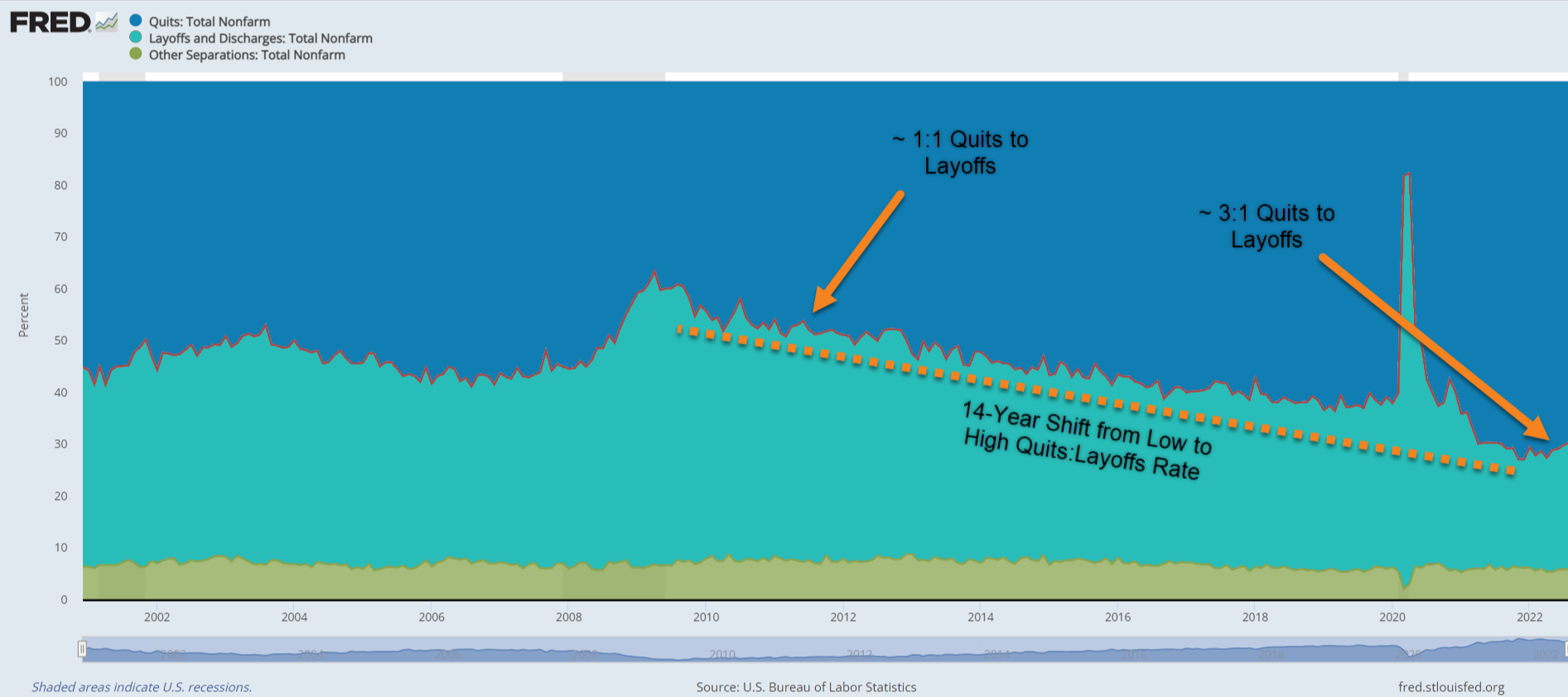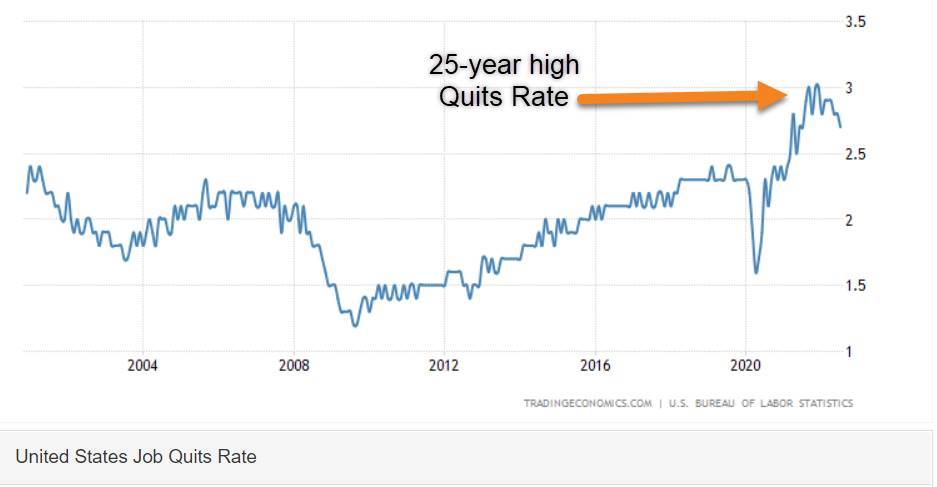Quiet Quitting: 3 steps companies can take to address the quiet quitting movement & costs.

Is Quiet Quitting Something for Employers to Worry About?
Quiet quitting statistics from a recent Gallup survey shows that 50% of employees meet the definition of quiet quitting given they fulfill the requirements of their job, but are disengaged. This is costly for companies in regards to spending time, money, and resources ineffectively.
What is quiet quitting?
Quiet Quitting (also know as soft quitting) is when an employee continues to do their job but with an “only what’s required” mentality. The term is new, but the concept isn’t (see coasting, slacking, disengaged, lazy etc.) So, should employers worry? What’s different this time?
How can businesses start addressing the quiet quitting movement?
In this blog, we argue that there are various factors causing quiet quitting in addition to the common conclusions of disengagement, burnout, and/or job dissatisfaction. By understanding these additional influences, leaders can address quiet quitting in their workplace, benefiting their team and creating a positive business impact overall.
What’s Driving Quiet Quitting Now?
1. People are Burned Out
7 out of 10 employees experienced burnout in 2022 according to Asana. Glassdoor negative reviews increased the mention of burnout by 48%.
While job demands can cause burnout, it also occurs when employees experience psychological distress such as:
- Feeling disrespected
- Masking one’s emotions at work
- Confusing work environment – poor communication/unclear objectives
Different work environments have different causes for burnout but the result is the same – disengagement.
2. There is a shift from “Hustle Culture” to “Soft Life”
Possibly because of being burned out, Gen Z and Millennials in the United States, China (the Lie Flat movement), and other parts of the world are opting for more purpose in their life.
“… about 70 percent of people say they define their purpose through work. And, actually, millennials, even more so, are likely to see their work as their life calling”. - Naina Dhingra, The McKinsey Podcast
Hustle culture promotes working beyond one’s limits to achieve massive career and financial success. The new idea of a “soft life” promotes an easier lifestyle focusing on one’s purpose and pursuit of ‘intentional happiness’ over financial gains.
This values shift away from building wealth for a stable life to purpose-fulfillment implies employers may need to compensate employees in more ways than money.
3. There is a Strong Job Market
A strong job market with record-high jobs going unfilled, the 20+ year low layoff rate, and remote work giving employees more options have all created an environment in which individuals are feeling high job security.
In July 2022, for every 1 person laid-off, 2.9 people quit. This is a significant shift in power compared to July 2010 when 1.2 people were laid off for every 1 person who quit (U.S. Bureau of Labor Statistics).
This environment, while favorable for employees, is a challenge for employers. Empowered employees are more likely to vote with their feet, demonstrated by the record-high quit rate and the great resignation.
21+ year low layoff rate & record-high quit rate

Low Unemployment

High quit Rate

Record High Job Vacancies

We see the strong labor market driving up job dissatisfaction as people have options and may feel “the grass is greener elsewhere.”
This cultural movement of changing values among younger generations is creating a misalignment with current work environments resulting in burnout and driving up disengagement.
Employers are starting to respond to the job market by increasing compensation and workplace flexibility. But what response is necessary to meet the demand for more purpose in work?
What are the costs of Quiet Quitting?
Considering that 50% of employees meet the definition of quiet quitting, it is very costly. Gallup states that voluntary turnover due to burnout costs companies 15% to 20% of total payroll. Work Institute estimates that turnover typically costs a company approximately 33% of an employee's base salary per departure. That cost is estimated to be about $15,000 for the average US employee.
Furthermore, quiet quitting causes teams to be inefficient and ineffective meaning lower company outputs, higher levels of production/process mistakes, and increased employee conflicts. Not to mention, addressing all these challenges is very costly to you and your leadership team’s time.
Leaders that take action to address burnout and disengagement can prevent some of the greatest workplace challenges they are facing and increase profitability and business impact.
What can leaders do?
There are three simple, actionable steps leaders can take to improve their company culture which in turn can address quiet quitting and increase employee engagement:
1. Establish your CorePurpose™
McKinsey & Company research shows that employees report anywhere from two to five times higher work and life outcomes when they feel their purpose is fulfilled by their work than what their unfulfilled peers report. Gallup research demonstrated an 8.1% decrease in turnover and a 4.4% increase in profitability when a company improved employees’ connection to the company purpose by 10%.
At The Culture Fix®, we believe every organization should have a CorePurpose™ - a statement that connects your team to the goodness you do for the world beyond the simplicity of your organizational outputs. Your core purpose should cover:
- CoreDateTM: A date in the future, usually 3 years out
- CoreTargetTM: A number pertaining to the amount of goodness you will deliver for the world.
- Company or Leader’s Why: Why you do what you do. The goodness you do for the world stated in a few words.
We suggest looking to the CEO, Founder or Visionary to begin the process of drafting this statement. Then, we highly encourage teams that include employees from all levels of the organization to work together to refine the statement. By establishing your CorePurpose and frequently communicating it throughout company operations, you can increase the fulfillment your people feel from their job.
2. Strengthen communication with core values
It's no secret that strong communication is a powerful asset to any team or organization. But a powerful, under-utilized strategy for strong communication is using your company’s CoreVals™ (core values) to empower employees and teams to have safe and effective communication.
Our research shows that less than 50% of employees can name less than 50% of their company’s core values. If employees, including leadership and even the founders who likely drafted them, aren’t able to remember the core values, then how can they be used as a tool for accountability and difficult conversations?
We believe that every company should have a CoreChart™ that consists of unique core values, descriptive behaviors that define what the values mean in the context of the company and a CorePurpose™. This can then be used as an organizational-wide guide for employees to hold their colleagues at all levels accountable to the agreed-upon behaviors. This can help to create safe spaces and provide language for employees to speak-up when they feel psychological distress and empower employee engagement.
Anatomy of a CoreChart™

3. Unhire™ employees that don’t align with core values
Finally, we’ve found that the fastest way to change a company’s culture is to unhire those employees who do not align with company's core values - even if they are high performers.
Gallup reports that “unfair treatment at work” is the biggest source of burnout. In most cases, people who do not align with the shared values of a company are likely to cause a lot of friction in teams. These individuals may be causing psychological distress for their colleagues which can lead to burnout and quiet quitting behaviors.
The CoreScore tool from The Culture Fix allows your teams to assess employees on how well they demonstrate each of the company's core values on a daily basis. If an employee scores low, then it is unlikely they can be nurtured into being better teammates.
You can learn more about the CoreScore tool and use it with your teams by watching the video below.
The strategies and tools discussed in these steps can be found in The Culture Fix® book by Will Scott. In addition, you can learn more about these resources at www.theculturefix.works. If these three steps resonate with you and you’re interested in learning more about how you can facilitate a company culture transformation in your organization, contact us today.
We recommend reading the following posts.
The best company culture books
Want to learn how to change your company's culture?
Learn how to become a corporate culture consultant.



